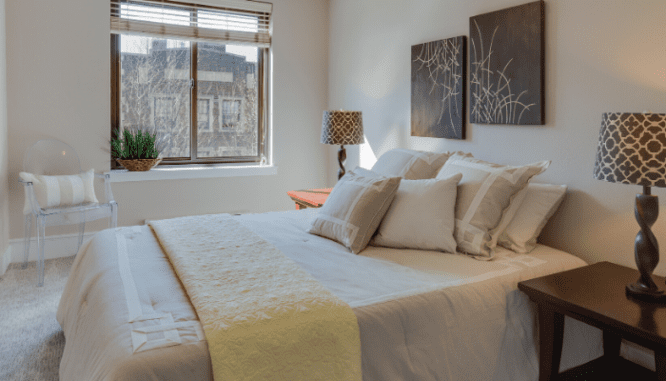Steps to Selling Your Home You Didn’t Know Could Be Done Virtually
- Published on
- 5 min read
-
 Christine Bartsch Contributing AuthorClose
Christine Bartsch Contributing AuthorClose Christine Bartsch Contributing Author
Christine Bartsch Contributing AuthorFormer art and design instructor Christine Bartsch holds an MFA in creative writing from Spalding University. Launching her writing career in 2007, Christine has crafted interior design content for companies including USA Today and Houzz.
Just as you can meet with your doctor over the phone, order groceries through an app, and work from the safety of your living room, so too can you sell a home in this new world — it’s just a matter of taking a different approach. And because many would-be sellers don’t see it that way, opportunity awaits for those who are willing to get creative right now.
“With everything going on with COVID-19, I find that sellers who are not highly motivated to make a move, are not making one,” says Amy Rio, a top-selling agent in Hartford, Connecticut. “People have stalled off putting their house on the market, preferring to wait until we’re done with social distancing because they’re afraid. And because there are fewer sellers who are willing to risk selling a pandemic, there are a lot more buyers who are desperate for houses right now.”
If you have trouble imagining anything but unwanted visitors in your home and risky open houses, let go of those traditional real estate assumptions and read on. We’ve spoken to a number of top agents across the country who told us how they’re taking every step of the home sale process and adapting it to a COVID-19 environment — and even we were surprised by how much you can do virtually or from a safe distance.

Step 1: Interview your agents
Then: Hold in-person agent interviews.
Now: Host virtual agent interviews.
Hiring an experienced agent who can take all the COVID-19 changes in stride is priority one when you’re selling a house during a pandemic. But that doesn’t mean you need to invite several agents into your home or sit directly across a desk from anyone.
“A lot of people are really scared and isolated, so we’ve definitely learned how to create relationships without meeting in person,” advises Spokane, Washington-based agent Cambria Henry.
“I recommend FaceTime or Zoom meetings over phone calls because you don’t know how that person actually presents until you’re face-to-face with them. However, you really have to pay attention to somebody when they’re on a screen versus when they’re right in front of you.”
Assess your rapport with each agent and come prepared to your video conference interviews with a list of questions to evaluate their experience and their COVID-19 preparedness. For example:
- What is your experience selling houses in my neighborhood, price point, and property type?
- How have you adjusted your business practices to account for COVID-19 safety requirements?
- What is your sale-to-list price ratio and how does it compare to other agents? (In other words, do you sell houses for more money on average than other agents?)
- Do you provide any complimentary marketing as part of your listing services, such as staging help, or professional listing photos?
Step 2: Give your agent a virtual walkthrough
Then: Walk through the home with your agent to assess the overall condition.
Now: Host a video call like FaceTime or Zoom and virtually walk your agent through the home to assess the condition.
Oftentimes sellers will give their agent a walkthrough of the home as part of the listing appointment. This is another part of the process that you can do over video if you aren’t comfortable with an in-person meeting. (Wearing masks, gloves, and staying six feet apart is another option).
“During our virtual initial listing appointment, I have sellers just walk me through the home slowly so I can see everything and assess the home inside and out. I even have them walk across the street so I can see the condition of the roof,” explains Henry.
Expect a virtual walkthrough to take an hour or two. You’ll need to show off your home’s best features and be transparent about its known flaws. Without this information, your agent can’t make an accurate assessment of your home’s condition or get to the next step — evaluating your home’s current value to set the list price.
Step 3: Review your agent’s CMA to price the home
Then: Review a physical copy of your agent’s comparative market analysis at a table together.
Now: Review a digital copy of your agent’s comparative market analysis or have your agent drop it off.
Once you’ve hired an agent, he or she will need to go over the comparative market analysis (CMA) with you. The CMA is used to determine how your home stacks up against the competition and how much it is likely to sell for on the open market.
While the CMA has traditionally been compiled in something like a physical binder, you and your agent can each review and refer to your own digital copy of the CMA, or your agent can drop off their analysis at your doorstep. You can then thumb through it page by page on another conference call.
“We’ll compare the seller’s house to the comps, noting any differences in the number of rooms, lot size, even the kitchen quality,” says Henry. “If your house has a gorgeous kitchen island and another comp doesn’t, buyers will find your house more attractive. This is the information we need to decide the best list price for their home.”

Step 4: Prep and stage your home for listing photos
Then: Hire pros to come clean, organize, and stage your home.
Now: Get a digital staging consultation and DIY the rest of the work.
In the COVID-19 era, you’re likely already doing all you can to keep your home clean, fresh, and virus-free. So most sellers these days already have a jumpstart on deep cleaning their home before buyers come through.
Another upside to being stuck at home is the extra free time to declutter and depersonalize so that buyers can focus on your house rather than your stuff. That free time is also useful for DIYing small repair projects and updates, like repainting your interiors in a neutral hue.
One area where sellers may still need expert advice to get the job done right is staging the house to sell quickly. It takes an expert eye to find the right balance between over-decorated and a stark, barren décor.
If you’ve properly completed step one, you’ll have hired an agent who has a pro stager ready to help with a virtual staging consultation, or they’ll be trained as a stager themselves:
“I’m a stager as well as an agent, so I give my sellers a ‘honey do’ list for each room that explains what needs to be done in each room,” explains Rio. “If the house needs décor items to enhance the staging, we will also give them a product line list to purchase online through Amazon or other home décor stores. We typically recommend items in the trendy neutrals like whites and grays.”
For more tips, check out HomeLight’s guide to staging your home to sell during coronavirus.
Step 5: Showing the house to buyers
Then: Come one come all for open houses and showings.
Now: Use virtual tours and online marketing to promote the home online, and make sure buyers are serious before letting them book a tour.
Cleaning and staging your home won’t be easy when you’ve got the entire family stuck inside 24/7. Just keep in mind that you’re primarily prepping your home in order to get great photos and a standout video tour to accompany your listing so that you can limit in-person showings.
Pre-pandemic, agents sold homes by hosting open houses that allowed any interested party inside, and scheduling showings with all interested buyers, often without a screening process to determine the buyers’ financing or level of seriousness. In the COVID-19 era, agents are taking extra precautions to restrict showings to allow only serious buyers. Buyers are expected to view virtual tour videos first, or schedule a personalized remote showing hosted by the seller’s agent before they can request a physical tour of the property.
These steps are designed to limit the number of buyers allowed to schedule an in-person showing and require a lot of extra work, but they’re worth it.
“I recently sold a house using only a virtual FaceTime walkthrough. We started the virtual walkthrough out on the street to show them its curb appeal and then walked through absolutely everything,” recalls Rio.
“We weren’t just showing the pretty parts of the house, we were actually searching out all of its problems, too. The FaceTime walkthrough lasted about 45 minutes. It was more in-depth of a walkthrough than any in-person showing. But they were very comfortable that they saw everything and we successfully bid on that property.”
If there’s any chance that your home may be sold without the buyer ever setting a foot inside the home, you need to be sure that your virtual tours are thorough, and show all your home’s flaws as well as its assets, or you could find yourself in legal trouble:
“Sellers need to be careful that they disclose everything and don’t try to cover up something in the virtual tour,” advises Meyer. “Buyers will be looking for money back if they find something wrong that they should have been able to find if they had seen the property in person.”
Step 6: Accept an offer
Then: Meet with your agent to discuss multiple offers on the table.
Now: Discuss and accept offers virtually, and don’t jump the gun.
It’s common for agents to email offers to their sellers immediately, and to discuss the potential of each with a phone call. An in-person offer discussion might happen if there were several offers on the table — although agents have easily adapted to conducting these discussions via video conference.
But the biggest change is that COVID-19 has many nervous sellers ready to accept the very first offer just to get the home sold as quickly as possible. But that may not be the wisest move:
“Sellers are relying on their agents more than ever in the COVID-19 era. That’s why it’s so important to hire a professional agent who has the education and experience to really know what they’re doing,” advises Henry.
“For example, we’re encouraging our sellers to wait just a little bit longer to accept an offer because we’re still dealing with a lot of multiple offers.”

Step 7: Have the home inspected and appraised
Then: The buyer, buyer’s agent and the appraiser may attend the appraisal, and all parties get a paper copy of the appraisal and inspection report.
Now: Both the appraiser and the home inspector go into the home alone, and the reports are 100% digital.
You might be able to sell your home to a buyer who’s never set foot inside the house, but there are two people who typically insist on coming in: the appraiser and the home inspector.
Thankfully, the Federal Housing Finance Agency has granted flexibilities and alternatives for appraisals. These COVID-19 related changes mean that your buyer’s lender may allow for an alternative appraisal that’s conducted simply by pulling comps and maybe just a drive-by of the property.
While an appraiser may be able to assess your home’s value without entering the property, it’s not quite the same story with home inspections. An inspector can’t really assess the condition of a house without seeing inside. Fortunately, home inspectors are already practiced in social distancing.
“Most home inspectors didn’t allow anyone in the property with them, even before all the social distancing protocols came into play, not even the buyer. These days appraisers want to go into the house alone, too,” explains Rio.
“All the social distancing and virtual appointments are leading to everyone doing extra photography and extra note-taking, so the reports are getting humungous.”
Whether it’s just the inspector who needs to come inside your home, or if your buyer’s bank is insisting on an appraiser making an in-person inspection too, both professions have established guidelines to keep everyone safe in the COVID-19 era:
- The Appraisal Foundation Coronavirus FAQ
- International Association of Certified Home Inspectors COVID-19 Safety Standards
- American Society of Home Inspectors COVID-19 Updates by State
Step 8: Close on the home
Then: Buyers and sellers sign at the closing table with other people present.
Now: Buyers and sellers sign separately, either digitally or using social distancing.
Pre-pandemic, who attended a house closing would vary depending on where you lived. Some states had all parties together at the table, while others had the buyers and sellers sign separately. Either way, there were usually others at the table, including agents and a title company representative.
These days, the only person in the room will be you — if you’re even in a room at all. Some places have made accommodations for closings to be completed curbside, or through the exterior window. And some states even allow for remote online notarizations.
“We’re digitally signing almost everything. Depending on the loan, there’s now only three or four documents that they have to sign in person and have notarized,” says Henry. “Our closing company saw this coming and got busy figuring everything out, to the point where clients can choose to do the signing at their home with a mobile notary. If they do come into the office to sign, everything is pre-sanitized, and there’s just the paperwork and a pen that the client takes with them when they’re done. They even switch out the chair once the client leaves.”
Staying safe when selling a home during the COVID-19 era is a top priority for everyone involved, including your agent, your buyer, your buyer’s agent, and the title company. With everyone working hard to sanitize, social distance, and follow the CDC guidelines for COVID-19 safety, you can put your mind at ease about putting your home on the market.
Header Image Source: (Chris Spiegl / Unsplash)
